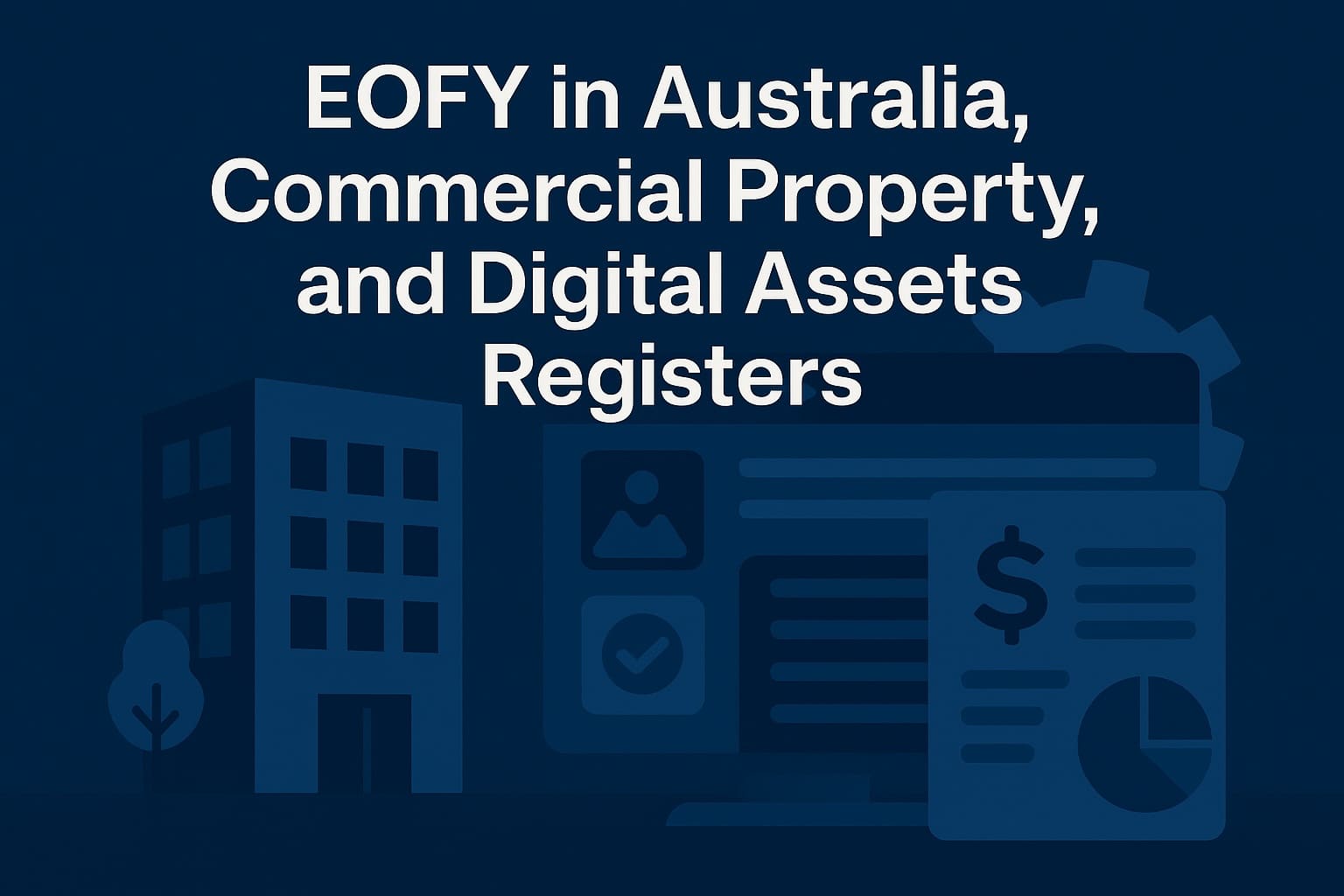
EOFY in Australia: Why Now’s the Time to Get Your Digital Asset Register in Order
BlogAs the Australian financial year draws to a close on June 30, property owners, facility managers, and operations teams shift into overdrive. It’s a time for reporting, reconciling, forecasting—and for some—scrambling.
For commercial property professionals, EOFY isn’t just about ticking compliance boxes. It’s a strategic window to review capital expenditure (CapEx), operational expenditure (OpEx), and long-term asset planning. And in this context, having an accurate, up-to-date digital asset register becomes more than a nice-to-have—it becomes a competitive advantage.
In this article, we’ll explore the opportunities and challenges that come with EOFY in the commercial property sector and how a digital asset register can streamline reporting, reduce risk, and support smarter decision-making.
The EOFY Crunch: Pressure Meets Opportunity
Every year, June signals the same mad dash: prepare financial statements, reconcile maintenance costs, assess asset depreciation, and get forecasts in shape for the next 12 months.
For property managers and asset owners, this usually involves pulling together:
- Maintenance logs and work orders
- Equipment condition reports
- Replacement schedules
- Service contracts
- Invoicing records for CapEx/OpEx categorisation
The challenge? Much of this data is still spread across PDFs, spreadsheets, contractor portals, or in someone’s head.
CapEx vs OpEx: Why Clarity Matters
One of the biggest EOFY headaches is distinguishing Capital Expenditure (CapEx) from Operational Expenditure (OpEx)—and justifying each to auditors or financial stakeholders.
- CapEx refers to investment in assets with long-term value: HVAC system replacements, major roof repairs, plant upgrades.
- OpEx refers to recurring, day-to-day expenses: scheduled maintenance, energy bills, inspections, consumables.
Misclassifying spend can lead to tax errors, budget shortfalls, or worse—regulatory issues. A centralised, digital asset register ensures you can tag and track these correctly, with evidence.
Example:
Let’s say you replaced several air conditioning units this year. Without an asset register, that may be logged simply as “HVAC works.” With Ai Assets, you’ve got:
- The asset ID
- Manufacturer details
- Installation date
- Invoice amount
- Asset condition pre/post
- Warranty data
Now it’s clearly CapEx—fully documented and audit-ready.
The Pitfalls of Manual Reporting
Many commercial operators still rely on a patchwork of tools and processes:
- Static spreadsheets that go out of date quickly
- Paper-based checklists and inspection sheets
- Inconsistent naming conventions across departments
- Limited visibility for stakeholders not in the same office
These outdated methods carry real risks:
- Data loss or version conflicts
- Human error in reporting
- Redundancy in asset tracking (e.g., two teams servicing the same plant unknowingly)
- Inability to demonstrate compliance or asset condition during audits
Worse, they make EOFY a reactive fire drill instead of a proactive strategy session.
The Ai Assets Advantage
At aiassets.io, we built our platform to help property teams digitally transform their asset management—without overhauling everything at once.
Here’s how our digital asset register supports EOFY processes:
Smarter Data Collection
From QR code scanning to mobile inspections, your team can collect asset data on-site and sync it instantly to the platform. No more clipboards or back-office delays.
Real-Time Asset Visibility
See every asset across your portfolio—by site, category, condition, age, and replacement status. Filter for high-risk, warranty-nearing, or upcoming replacements in seconds.
CapEx/OpEx Reporting
Categorise spend accurately and generate custom reports that align with ATO classifications or your internal accounting framework.
Handover-Ready Compliance
Easily export data sets for auditors, investors, or new contractors. Whether you’re preparing for a financial audit or planning a building handover, your asset data is ready.
EOFY Isn’t Just for Finance Teams
While EOFY is traditionally the domain of finance and compliance officers, it’s also a valuable time for operational reflection.
Smart property leaders use EOFY to ask:
- Are we reactive or proactive with maintenance?
- What assets are reaching end-of-life?
- How much did we spend unplanned vs planned?
- Are we leveraging asset data to inform our budgets?
If you don’t have instant answers to these questions, you’re not alone. But the longer asset data lives in disconnected silos, the harder it becomes to optimise operations.
A Digital Register Pays for Itself
Aside from making EOFY smoother, investing in a digital asset platform like Ai Assets creates year-round value:
|
Benefit |
Impact |
|---|---|
|
Time savings |
Less time compiling reports, more time on strategic work |
|
Reduced duplication |
Stop paying twice for asset assessments or maintenance |
|
Predictive planning |
Flag issues before they become expensive emergencies |
|
Transparent compliance |
Clear audit trails for every service, asset, and spend |
|
Better supplier management |
Clear visibility on what’s been done and what’s overdue |
Key Considerations Before EOFY Closes
If you’re thinking about upgrading your asset management system before June 30, there are a few things to keep in mind:
-
Tax Timing – Certain software expenses may be deductible in the current financial year if purchased before EOFY.
-
Budget Use-It-Or-Lose-It – Unused operational budgets could be reallocated toward tools like Ai Assets to lock in value.
-
Team Training – Introducing a digital platform now allows time for training before the next major compliance cycle.
-
Data Import – We offer assisted onboarding to migrate your spreadsheets or existing registers—no data left behind.
Ready to Wrap Up This Financial Year Strong?
EOFY is more than a reporting deadline—it’s a chance to reset your asset strategy and build momentum for the new year.
If your team is spending more time compiling spreadsheets than making decisions, it’s time to act. A modern, flexible digital asset register will help you:
- Plan better
- Report smarter
- Reduce risk
- Build long-term asset value
Let’s make EOFY the start of something better.
👉 Book a demo today and take control of your asset management before June 30.




